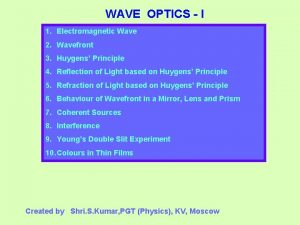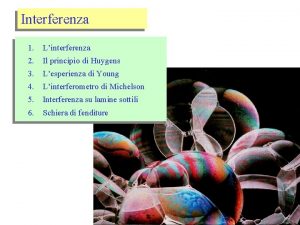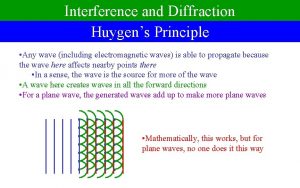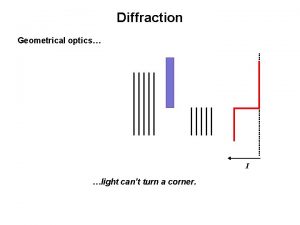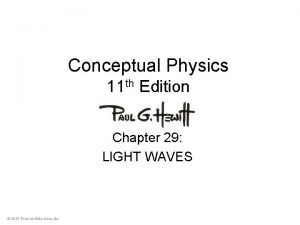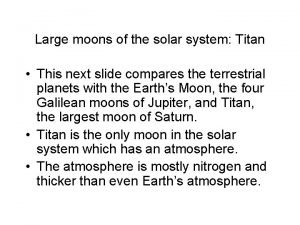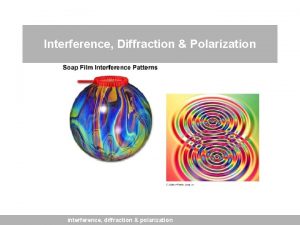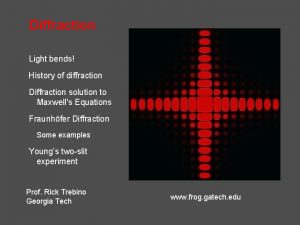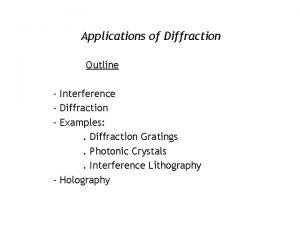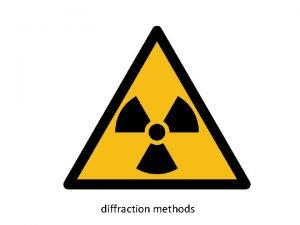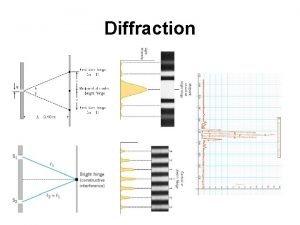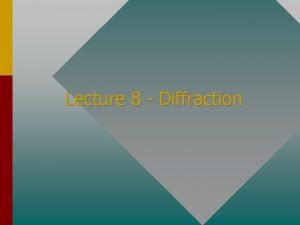Chapter 38 Diffraction Patterns and Polarization Diffraction Huygens














- Slides: 14

Chapter 38 Diffraction Patterns and Polarization

Diffraction • Huygen’s principle requires that the waves spread out after they pass through slits • This spreading out of light from its initial line of travel is called diffraction • In general, diffraction occurs when waves pass through small openings, around obstacles or by sharp edges

Diffraction • A single slit placed between a distant light source and a screen produces a diffraction pattern • It has a broad, intense central band • The central band is flanked by a series of narrower, less intense secondary bands called secondary maxima • The central band will also be flanked by a series of dark bands called minima • This result cannot be explained by geometric optics

Fraunhofer Diffraction • Fraunhofer Diffraction occurs when the rays leave the diffracting object in parallel directions • The screen is very far from the slit and the lens is converging • A bright fringe is seen along the axis (θ = 0) with alternating bright and dark fringes on each side Joseph von Fraunhofer 1787 – 1826

Single Slit Diffraction • According to Huygen’s principle, each portion of the slit acts as a source of waves • The light from one portion of the slit can interfere with light from another portion • The resultant intensity on the screen depends on the direction θ • All the waves that originate at the slit are in phase

Single Slit Diffraction • Wave 1 travels farther than wave 3 by an amount equal to the path difference (a / 2) sin θ • If this path difference is exactly half of a wavelength, the two waves cancel each other and destructive interference results • In general, destructive interference occurs for a single slit of width a when sin θdark = mλ / a; m = 1, 2, …

Single Slit Diffraction • The general features of the intensity distribution are shown • A broad central bright fringe is flanked by much weaker bright fringes alternating with dark fringes • The points of constructive interference lie approximately halfway between the dark fringes

Polarization of Light • An unpolarized wave: each atom produces a wave with its own orientation of E, so all directions of the electric field vector are equally possible and lie in a plane perpendicular to the direction of propagation • A wave is said to be linearly polarized if the resultant electric field vibrates in the same direction at all times at a particular point • Polarization can be obtained from an unpolarized beam by selective absorption, reflection, or scattering

Polarization by Selective Absorption • The most common technique for polarizing light • Uses a material that transmits waves whose electric field vectors in the plane are parallel to a certain direction and absorbs waves whose electric field vectors are perpendicular to that direction

Polarization by Selective Absorption • The intensity of the polarized beam transmitted through the second polarizing sheet (the analyzer) varies as I = Io cos 2 θ, where Io is the intensity of the polarized wave incident on the analyzer • This is known as Malus’ Law and applies to any two polarizing materials whose transmission axes are at an angle of θ to each other Étienne-Louis Malus 1775 – 1812

Polarization by Reflection • When an unpolarized light beam is reflected from a surface, the reflected light can be completely polarized, partially polarized, or unpolarized • It depends on the angle of incidence • If the angle is 0° or 90°, the reflected beam is unpolarized • For angles between this, there is some degree of polarization • For one particular angle, the beam is completely polarized

Polarization by Reflection • The angle of incidence for which the reflected beam is completely polarized is called the polarizing (or Brewster’s) angle, θp • Brewster’s Law relates the polarizing angle to the index of refraction for the material Sir David Brewster 1781 – 1868

Polarization by Scattering • When light is incident on a system of particles, the electrons in the medium can scatter – absorb and reradiate – part of the light (e. g. , sunlight reaching an observer on the ground becomes polarized) • The horizontal part of the electric field vector in the incident wave causes the charges to vibrate horizontally • The vertical part of the vector simultaneously causes them to vibrate vertically • Horizontally and vertically polarized waves are emitted

Optical Activity • Certain materials display the property of optical activity • A substance is optically active if it rotates the plane of polarization of transmitted light • Optical activity occurs in a material because of an asymmetry in the shape of its constituent materials
 Diffraction and polarization
Diffraction and polarization Em wave2
Em wave2 Moment d'inertie
Moment d'inertie Modello ondulatorio
Modello ondulatorio Interferenza su lamine sottili
Interferenza su lamine sottili Wave
Wave Cintiques
Cintiques Paul huygens
Paul huygens Jovian gas giant
Jovian gas giant Principiul lui huygens
Principiul lui huygens Fresnel and fraunhofer diffraction difference
Fresnel and fraunhofer diffraction difference Huygens principle features wavefronts that are composed of
Huygens principle features wavefronts that are composed of Huygens
Huygens Huygens
Huygens Christiaan huygens manometer
Christiaan huygens manometer

